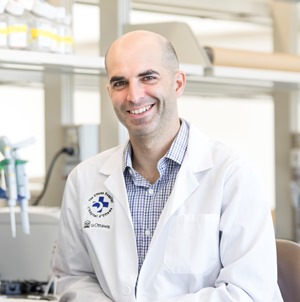 The nucleus of a cell is usually a highly organized structure, with more than a metre of DNA packaged very carefully into a tiny volume. A number of degenerative diseases, including Alzheimer’s, SCA7 and progeria are associated with a breakdown in nuclear organization.
The nucleus of a cell is usually a highly organized structure, with more than a metre of DNA packaged very carefully into a tiny volume. A number of degenerative diseases, including Alzheimer’s, SCA7 and progeria are associated with a breakdown in nuclear organization.
New research led by Dr. Pierre Mattar and Dr. and Dr. Michel Cayouette sheds light on nuclear organization using eye cells as a model. Specifically, the team looked at a protein called Casz1 in mouse rod cells, which are responsible for vision in low light. They found that rod cells without Casz1 had disorganized nuclei, and this led to problems with gene expression and cell survival. They also found that Casz1 controls nuclear organization by blocking the expression of a protein called lamin A.
Future research could lead to a new understanding of nuclear organization and new targets for treating related diseases. See PNAS for details.
“If we can understand how DNA is packaged inside our cells, we may be able to develop treatments for a wide variety of diseases where this goes awry,” said Dr. Pierre Mattar, Scientist and Clifford, Gladys and Lorna J. Wood Chair for Research in Vision at The Ottawa Hospital, Assistant Professor, University of Ottawa.
Authors: Mattar P (The Ottawa Hospital, University of Ottawa), Stevanovic M (Montreal Clinical Research Institute, McGill University), Nad I (The Ottawa Hospital, University of Ottawa), Cayouette M (Montreal Clinical Research Institute, McGill University, Université de Montréal).
Core resources: Cell Biology and Image Acquisition
Funders and acknowledgements: Research at The Ottawa Hospital is possible because of donations from the community. This study was also supported by the Foundation for Fighting Blindness, the Canadian Institutes of Health Research, Fonds de recherche du Québec-Santé, the Gladys and Lorna J. Wood Chair for Vision Research at The Ottawa Hospital and the Gaëtane and Roland Pillenière Chair in Retina Biology at the Montreal Clinical Research Institute.
The Ottawa Hospital: Inspired by research. Driven by compassion
The Ottawa Hospital is one of Canada’s largest learning and research hospitals with over 1,100 beds, approximately 12,000 staff and an annual budget of over $1.2 billion. Our focus on research and learning helps us develop new and innovative ways to treat patients and improve care. As a multi-campus hospital, affiliated with the University of Ottawa, we deliver specialized care to the Eastern Ontario region, but our techniques and research discoveries are adopted around the world. We engage the community at all levels to support our vision for better patient care. See www.ohri.ca for more information about research at The Ottawa Hospital.
University of Ottawa: —A crossroads of cultures and ideas
The University of Ottawa is home to over 50,000 students, faculty and staff, who live, work and study in both French and English. Our campus is a crossroads of cultures and ideas, where bold minds come together to inspire game-changing ideas. We are one of Canada’s top 10 research universities—our professors and researchers explore new approaches to today’s challenges. One of a handful of Canadian universities ranked among the top 200 in the world, we attract exceptional thinkers and welcome diverse perspectives from across the globe. www.uottawa.ca
Media Contact
Jennifer Ganton
Director, Communications and Public Relations
Ottawa Hospital Research Institute
Office: 613-798-5555 x 73325
Cell: 613-614-5253
jganton@ohri.ca
